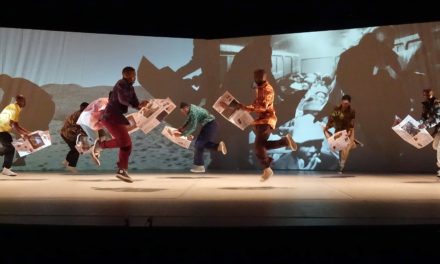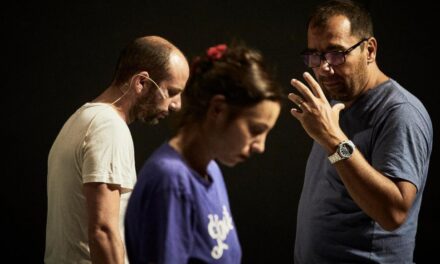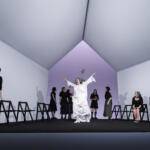The Brighton-based Blast Theory is one of the world leading interactive performance companies that combines elements of performance, installation and virtual reality. The company is at the forefront of using technology, doing research and actually “testing” human behaviour although they also have a clean-cut policy of handling big data of their audience. A conversation with Nick Tandavanitj.
What is Operation Black Antler about?
We were looking at the rise in surveillance and the practice of the British police of “deep swimming”: going undercover for months and years to investigate groups they thought to be politically extreme. At the time, there were animal liberation groups under investigation, leftist protest groups and environmental groups being targeted. Within this program police officers were pretending to be members of these groups: they were taking fake identities, having sexual relationships with the members of these groups and in some cases having children with them. This was subsequently uncovered by people in these groups who recognized that they were being infiltrated by the police. So we really wanted to try and make an experience that invited people to reflect on the ethics of this kind of surveillance and the potential for transgression and corruption in pretending to be someone else. We also wanted to tackle the issue of right wing rhetoric becoming increasingly common across Europe. It feels like right wing views about migration and religion are becoming more mainstream: centralist politicians are more adopting the same rhetoric and we wanted to see if is there is an intelligent way to reflect on this and the dilemmas in defining and policing extremism and in justifying surveillance. (This project was premiered on the 7th of May at Brighton Festival).

Nick Tandavanitj (source: blasttheory.co.uk)
You are bringing up many ethical and political issues, but how would you define more exactly the work of Blast Theory?
We have always made works that have a mission to maintain a sense of liveness and participation. They are accessible and adopt references, languages, and motives that draw on popular culture. Many of our pieces of work are designed to allow audiences to think about or to experience how technology is transforming our social relationships.
There is a study on your website that states: Blast Theory uses technology as an inquiry. Do you think it is still valid for your activity?
It varies. I think “inquire” is a nice way to think about it. We don’t often claim to have answers, it is more setting various points of views, of questions against each other and using people’s own experiences of the work to reflect on the questions. We have different modes of talking or different modes of construction of experiences. We still use traditional storytelling, where we’ll create characters and have stories that convey the background or the history or set a scene, atmospheres, contexts. But we commonly use different modes of address to change the role of the audience in the work or the story: we give tasks to people to allow them to think about something in direct relationship to themselves, or we set up a game mechanism where we potentially don’t know the outcome of the game or what strategies people might use to play the game. So those are more like inquiry, though often they are still quite linear. Not all of our works are emergent in how the storylines play out. Lots of the areas of the work that are interactive we’ve actually tested to the point where we have a good idea of what the possible outcomes are. It’s part of the design of the experience. In Karen, for example, there are a limited number of responses and the plot of the story itself is quite a linear even though it is interactive. The thing that distinguishes it as being interactive is that you are involved in the creation of the emotional relationship with Karen and you take responsibility for this.
Are you always testing to the end all the games that you are developing?
Yes. For example, with Karen, the very first tests for it were at the end of the first two-week development sprint in March 2014. We had a long break over the summer and ran another development sprint and internal user test with about a dozen people in the autumn. This second test changed the character of the work a lot. You learn so much about all the stuff that is just very boring or unpredictable. What works can be surprising. Testing then continued right up to the release in the app store, modifying the story and changing the script in response to feedback from tests.
Is it a theoretical thought what you want to develop, and at the end is it something else? Does it happen often or does your outcome always reflect your preliminary idea?
I think it’s rare that anything comes out as you originally planned it. For example with Karen, we had probably three or four starting points: one of the starting points was that we looked at the documentary The Century of Self, about Freud, marketing, and politics. It was just very interesting to understand how psychometric profiling is used across a lot of different areas, from marketing and corporate recruitment to training and policy making. We found that a powerful thought: that actually people are now predictable, and that if you know what mechanisms are at work, that is a powerful position to be in. The second was a work, Day of the Figurines, an SMS game that takes place over 24 days, that we created as part of a research project investigating pervasive gaming. The definition of a pervasive game is one that breaks or extends one of the usual boundaries of a game. For example, a board game takes place at a particular time in a particular space and with a particular set of players agreed in advance. A pervasive game breaks one of those boundaries. For example, the Day of the Figurines breaks the rule of being in a single time and in a single space. Games are a very nice mechanism for giving people an understanding what the licenses are for them to behave in an experience. It also allows them to be playful with their identity or explore behaviors outside the context of their daily lives. But if it’s pervasive, you can also bring in a kind of residency in everyday life that supports, or echoes the behaviours you invite within the context of the game. The third starting point was using agents or characters within a mobile experience. Mobile devices come from telephones. They come from this place that connects you to someone at a remote location, that connects two different, real places. So, using this notion we are not watching, we are making a telephone call or video call – that was the third insight for Karen. All of these were starting points in the vision of what we wanted to create, but in the end, Karen is quite a lot different, the experience is probably a lot more like an interactive drama than we planned.
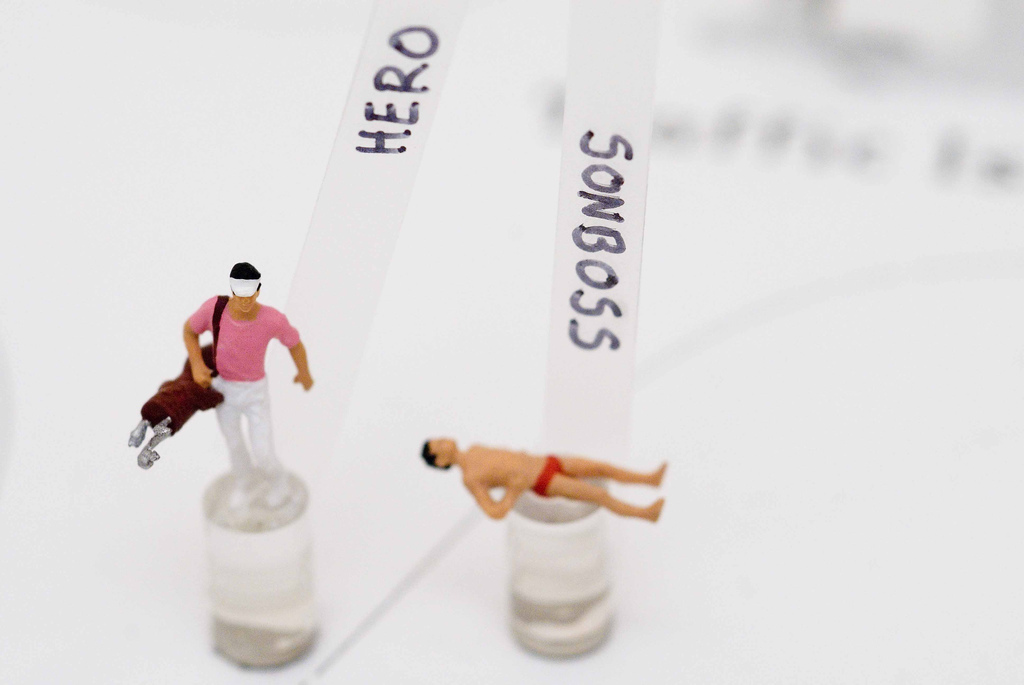
Day of the Figurines (source: http://blasttheory.co.uk)
Are you also working with social sciences on these kinds of experiments?
Yes, the main research collaborator on Karen was a data scientist called Dr. Kelly Page. She has a background in research in psychometric profiling and behavior, especially online. She previously worked with Google AdWords and has since started to work with arts organisations such as National Theatre Wales; helping them to understand their relationship with the audiences, in relation to networks and digital environments.
You were conducting workshops also about how digital apps and/or big companies are gathering data about the single user. Did you also face this delicate issue?
For Karen, data privacy and security were key issues. In England, we have strict data protection rules, under which anyone who is holding personal data is regarded as a data controller. This requires that we have to set out and comply with a data privacy policy for work such as Karen and make sure that we take steps to ensure the security of people’s personal data. For Karen, any data that personally identifies you, such as email and geo-location, is stored separately from the behavioral and profiling data, and is stored as encrypted at rest. You can request that your data is deleted at anytime or request a copy of it. In 2010, Channel 4 in the UK invited us to make a mobile work, Ivy4Evr, using an agent as the central character in an interactive drama. We were working with teenagers talking about subjects that couldn’t be discussed with adults easily, such as sexual experiences and drug use. We created a teenage character that was going through all sorts of trials, and teenagers could talk to her via text messages. And we were storing that data, so there was a massive data set from teenagers, with their phone numbers, recording details of their personal lives, such as what their sexual experiences were. For this, we had to go through quite a strict compliance and security process with Channel 4. That was a very good learning experience for us.
You started more from the performative side of interactive arts. Are you sometimes “going back” to live performance, to mix interactive art with live performance or you are tending more to mobile assets?
We often make work that is digitally distributed. For us, Karen is the least ‘live’ work that we have made. In general, we consider all of our work as live, as it takes place in real time in some way. We still do performance that is face-to-face, like now with Operation Black Antler. For this work, we created a text messaging platform for orchestration in the background alongside a professional cast of six actors and an ensemble cast of over twenty.
When you are working together with your colleagues are you sharing the tasks on areas?
During the early 1990s, when the company was founded, rave culture was at its height in the UK. Matt Adams and Ju Row Farr, the two other artists and the founders of the company, had a common interest in making work that was accessible and exciting; that combined the energy of rave culture with the critical potential to theatre. And now when we work we still have that kind of goal: we make work with technology that is intended to be accessible, vibrant and that can resonate with people’s use of technology in their own lives. In terms of individual roles, it varies from project to project. Something like Karen, for example, is an entirely new platform for us. It is a software-heavy project but also required a lot of creative development around scripting and shooting non-linear video. The way we run projects is that we agree one lead artist out of the three of us, who owns the creative vision of the work and normally spends the most time on the work. They make sure that meetings are scheduled, that there is a creative time for the artists, they schedule the work for developers, and oversee the plan for delivering the work. In every project, there are different stages of development and collaboration between Matt, Ju and I: in how it takes shape at a conceptual stage, on the experience design, and on the interaction design. In the actual production stages, we tend to take different roles. For example, Matt and Ju tend to work more with actors and performers and Matt is used to working more in writing scripts. I tend to work more in technical design and visual design, Ju often works in visual design as well, but more in the area of conceptual development and production design and less screen design. And so we all have slightly different areas of expertise.
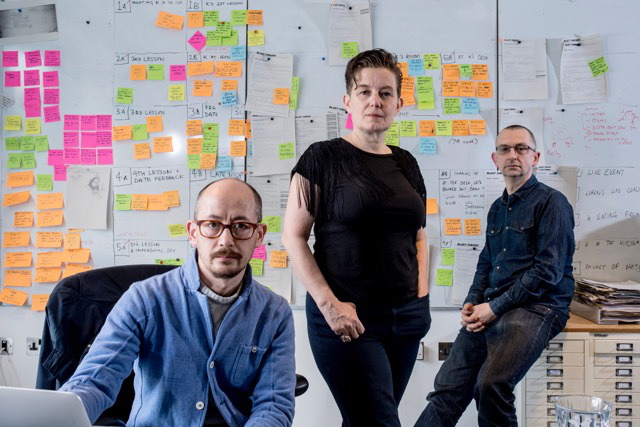
Nick Tandavanitj, Ju Row Farr, Matt Adams (source: blasttheory.co.uk)
About the financing how are you working? Do you have a yearly operational grant? How can you manage it?
We have a mixed set of sources for funding. We receive an annual grant from Arts Council England of about £130,000 that we have to re-apply for every 3 years but our annual turnover is more like £300-400,000, so this is about one-third of our income. A further third comes from commissions, presenting work, fundraising activity like Kickstarter and ticket sales from events, and the last third comes from teaching, research projects and work with universities.
Can you tell me a bit more about the last? I have seen that you have a long relationship with the Mixed Reality Lab from the University of Nottingham.
When we first met Professor Steve Benford from the Mixed Reality Lab, they were already working with artists, poets, and performers and they invited us to be a consultant in the lab work. At the time, we were reading about the 1991 Gulf War, and having met them and seen the technologies they were working with, we developed a show with them, Desert Rain, that dealt with some of the questions of virtuality and technology in the context of the Gulf War. We then went on to work with them on projects looking at emerging mobile technologies in the early 2000’s. After about 3-4 years, they invited us to become a research partner in an EU funded project on pervasive gaming. That was the first time we actually became a research partner. We have since developed and led our own research projects: setting our own agenda and inviting research partners. These projects have allowed us space to work in areas that are entirely new and with technologies that we probably wouldn’t have been able to access otherwise. We’re not interested so much in technology and innovation for its own sake, though. The issue we are working with in terms of technology is often more: how do people understand the potential and impact of the technology that is already out there.
How do you see the future of your work, for example in 30 years?
What seems striking in technology circles at the moment is the amount of interest in virtual headsets and ‘immersive’ technology. The idea of standing in the middle of your living room with a headset on fills me with no happiness at all. In terms of technology, I hope that in situations where we are constantly surrounded by digital or network connected devices, the technology can be used, in some way, to re-insist on our co-dependence and co-presence. I suppose it’s the difference between going to see a film like Transformers IV, where 80% of what you see on screen is CGI; it’s the work of very clever people and amazing technology, but everyone has a perfect skin, and it’s very efficient. It delivers entertainment. It’s the difference between this and something about making things alive, with a sense of humanity. New forms of technology, will hopefully allow people’s sense of humor, sense of irony and vulnerability remain present. I don’t know what form it will take, but I hope we still feel equally vulnerable and sensitive to each other.
This article was originally published on Zip-scene.com. Reposted with permission. Read the original article.
This post was written by the author in their personal capacity.The opinions expressed in this article are the author’s own and do not reflect the view of The Theatre Times, their staff or collaborators.
This post was written by Ágnes Bakk.
The views expressed here belong to the author and do not necessarily reflect our views and opinions.


